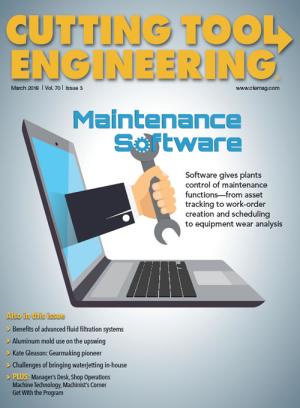As product miniaturization continues, micromachining continues to make inroads into the manufacturing industry. CTE will once again provide a special section about micromachining in our May issue.
At the other end of the size spectrum, I’ve noticed more developments in large-part machining. Coincidentally, our April issue will include a focus on that topic. As part of our planned coverage, I visited Coldwater (Ohio) Machine Co. and will present a profile about the shop’s expertise in producing short runs of massive components, many of which are for the special machines CMC builds.
Prior to visiting Coldwater, I had the opportunity to drop by the production facility for FlexArm Inc./FlexDrill CNC in Wapakoneta, Ohio. While there, I saw an example of FlexDrill’s GRD-series gantry machining center. The 3-axis CNC machine has an X-axis up to 30' (9.1m) and a 4' (1.2m) or 6' (1.8m) Y-axis, enabling long parts to be processed in one setup.
When it comes to machining large parts, getting it “done in one” is a huge benefit. A single setup not only avoids the dimensional-tolerance stack-up and setup errors that can occur but minimizes movement of cumbersome workpieces.
Turning to the current issue, the Industry Briefs section includes a report about the new Emco Mecof Powermill 5-axis vertical machining center at Baker Industries Inc., Macomb, Mich.
Large enough to hold two semitrailers on its platform, the machine enables Baker Industries to produce colossal components—up to 16m (52.5') or larger—such as assembly and bond jigs for the aerospace industry. The Powermill lets Baker perform everything from roughing to finishing on one machine.
Of course, when going large, the investment in time and money is also grand. Baker Industries reports that the 11-month construction and build project for the Powermill cost $3.4 million.
For another large gantry mill—this one built by Fives Liné Machines Inc. (CTE covered this in the February issue’s Productive Times section)—Sonaca Montreal Inc., Mirabel, Quebec, wouldn’t divulge the cost. Nonetheless, it was pricey enough that short-term loans provided by the Canadian and Quebec governments supported the purchase of the 5-axis vertical gantry mill, which can machine parts up to 70' (21.3m) long and 10' (3.05m) wide.
I expect to hear more about megamachines coming online as the quest continues—particularly among aerospace OEMs—to machine more massive, monolithic structures to reduce assembly. Doing so will reduce costs and strengthen the final product.
Related Glossary Terms
- computer numerical control ( CNC)
computer numerical control ( CNC)
Microprocessor-based controller dedicated to a machine tool that permits the creation or modification of parts. Programmed numerical control activates the machine’s servos and spindle drives and controls the various machining operations. See DNC, direct numerical control; NC, numerical control.
- machining center
machining center
CNC machine tool capable of drilling, reaming, tapping, milling and boring. Normally comes with an automatic toolchanger. See automatic toolchanger.
- milling machine ( mill)
milling machine ( mill)
Runs endmills and arbor-mounted milling cutters. Features include a head with a spindle that drives the cutters; a column, knee and table that provide motion in the three Cartesian axes; and a base that supports the components and houses the cutting-fluid pump and reservoir. The work is mounted on the table and fed into the rotating cutter or endmill to accomplish the milling steps; vertical milling machines also feed endmills into the work by means of a spindle-mounted quill. Models range from small manual machines to big bed-type and duplex mills. All take one of three basic forms: vertical, horizontal or convertible horizontal/vertical. Vertical machines may be knee-type (the table is mounted on a knee that can be elevated) or bed-type (the table is securely supported and only moves horizontally). In general, horizontal machines are bigger and more powerful, while vertical machines are lighter but more versatile and easier to set up and operate.
- sawing machine ( saw)
sawing machine ( saw)
Machine designed to use a serrated-tooth blade to cut metal or other material. Comes in a wide variety of styles but takes one of four basic forms: hacksaw (a simple, rugged machine that uses a reciprocating motion to part metal or other material); cold or circular saw (powers a circular blade that cuts structural materials); bandsaw (runs an endless band; the two basic types are cutoff and contour band machines, which cut intricate contours and shapes); and abrasive cutoff saw (similar in appearance to the cold saw, but uses an abrasive disc that rotates at high speeds rather than a blade with serrated teeth).
- turning
turning
Workpiece is held in a chuck, mounted on a face plate or secured between centers and rotated while a cutting tool, normally a single-point tool, is fed into it along its periphery or across its end or face. Takes the form of straight turning (cutting along the periphery of the workpiece); taper turning (creating a taper); step turning (turning different-size diameters on the same work); chamfering (beveling an edge or shoulder); facing (cutting on an end); turning threads (usually external but can be internal); roughing (high-volume metal removal); and finishing (final light cuts). Performed on lathes, turning centers, chucking machines, automatic screw machines and similar machines.


